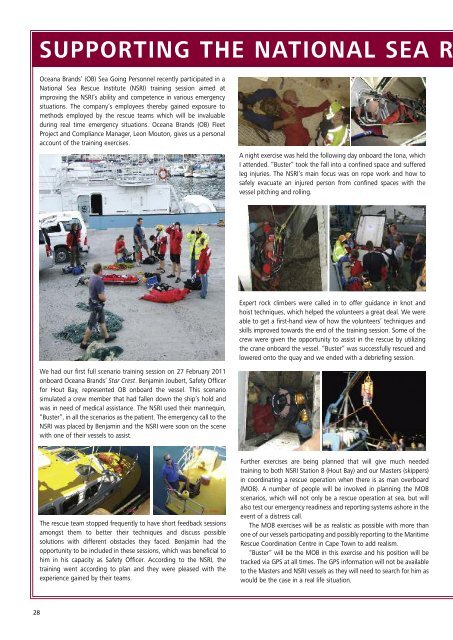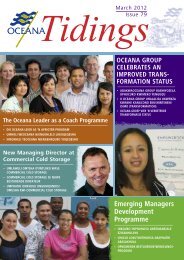April 2011 - Oceana Group
April 2011 - Oceana Group
April 2011 - Oceana Group
You also want an ePaper? Increase the reach of your titles
YUMPU automatically turns print PDFs into web optimized ePapers that Google loves.
28<br />
SUPPORTING THE NATIONAL SEA R<br />
<strong>Oceana</strong> Brands’ (OB) Sea Going Personnel recently participated in a<br />
National Sea Rescue Institute (NSRI) training session aimed at<br />
improving the NSRI’s ability and competence in various emergency<br />
situations. The company’s employees thereby gained exposure to<br />
methods employed by the rescue teams which will be invaluable<br />
during real time emergency situations. <strong>Oceana</strong> Brands (OB) Fleet<br />
Project and Compliance Manager, Leon Mouton, gives us a personal<br />
account of the training exercises.<br />
We had our first full scenario training session on 27 February <strong>2011</strong><br />
onboard <strong>Oceana</strong> Brands’ Star Crest. Benjamin Joubert, Safety Officer<br />
for Hout Bay, represented OB onboard the vessel. This scenario<br />
simulated a crew member that had fallen down the ship’s hold and<br />
was in need of medical assistance. The NSRI used their mannequin,<br />
“Buster”, in all the scenarios as the patient. The emergency call to the<br />
NSRI was placed by Benjamin and the NSRI were soon on the scene<br />
with one of their vessels to assist.<br />
The rescue team stopped frequently to have short feedback sessions<br />
amongst them to better their techniques and discuss possible<br />
solutions with different obstacles they faced. Benjamin had the<br />
opportunity to be included in these sessions, which was beneficial to<br />
him in his capacity as Safety Officer. According to the NSRI, the<br />
training went according to plan and they were pleased with the<br />
experience gained by their teams.<br />
A night exercise was held the following day onboard the Iona, which<br />
I attended. “Buster” took the fall into a confined space and suffered<br />
leg injuries. The NSRI’s main focus was on rope work and how to<br />
safely evacuate an injured person from confined spaces with the<br />
vessel pitching and rolling.<br />
Expert rock climbers were called in to offer guidance in knot and<br />
hoist techniques, which helped the volunteers a great deal. We were<br />
able to get a first-hand view of how the volunteers’ techniques and<br />
skills improved towards the end of the training session. Some of the<br />
crew were given the opportunity to assist in the rescue by utilizing<br />
the crane onboard the vessel. “Buster” was successfully rescued and<br />
lowered onto the quay and we ended with a debriefing session.<br />
Further exercises are being planned that will give much needed<br />
training to both NSRI Station 8 (Hout Bay) and our Masters (skippers)<br />
in coordinating a rescue operation when there is as man overboard<br />
(MOB). A number of people will be involved in planning the MOB<br />
scenarios, which will not only be a rescue operation at sea, but will<br />
also test our emergency readiness and reporting systems ashore in the<br />
event of a distress call.<br />
The MOB exercises will be as realistic as possible with more than<br />
one of our vessels participating and possibly reporting to the Maritime<br />
Rescue Coordination Centre in Cape Town to add realism.<br />
“Buster” will be the MOB in this exercise and his position will be<br />
tracked via GPS at all times. The GPS information will not be available<br />
to the Masters and NSRI vessels as they will need to search for him as<br />
would be the case in a real life situation.



